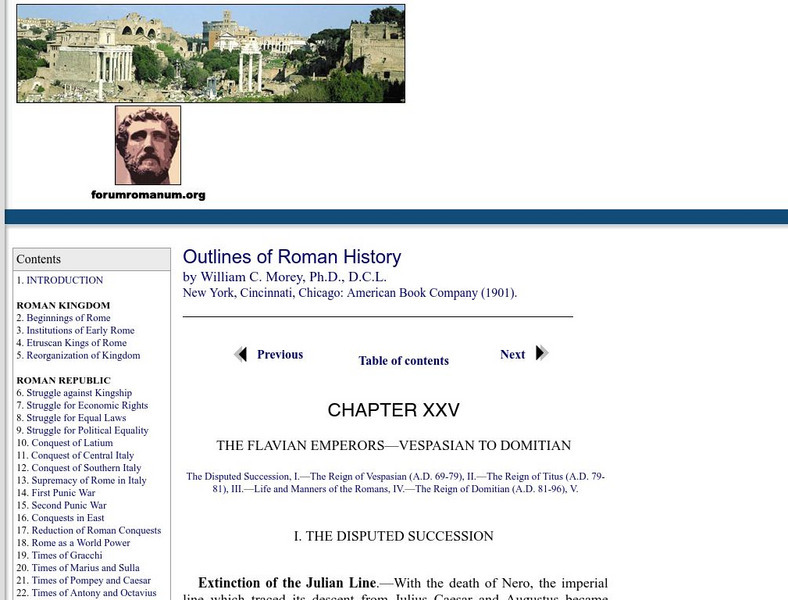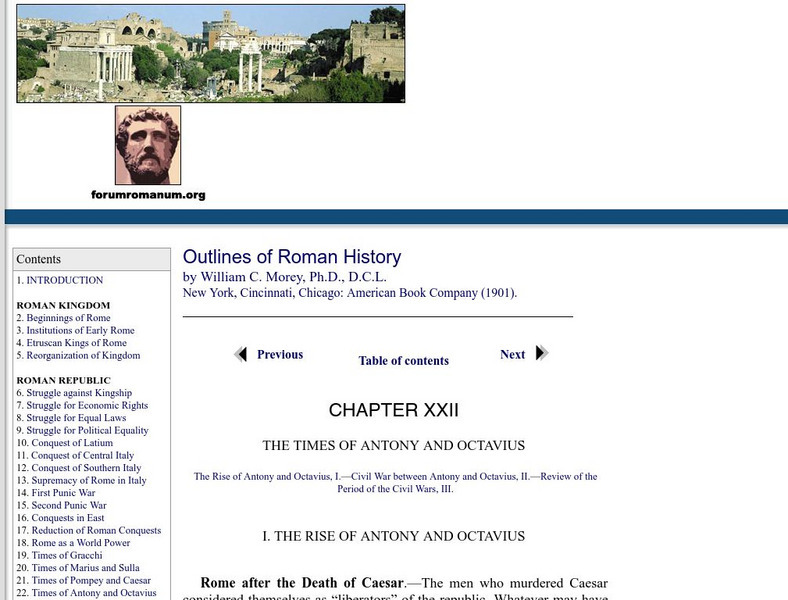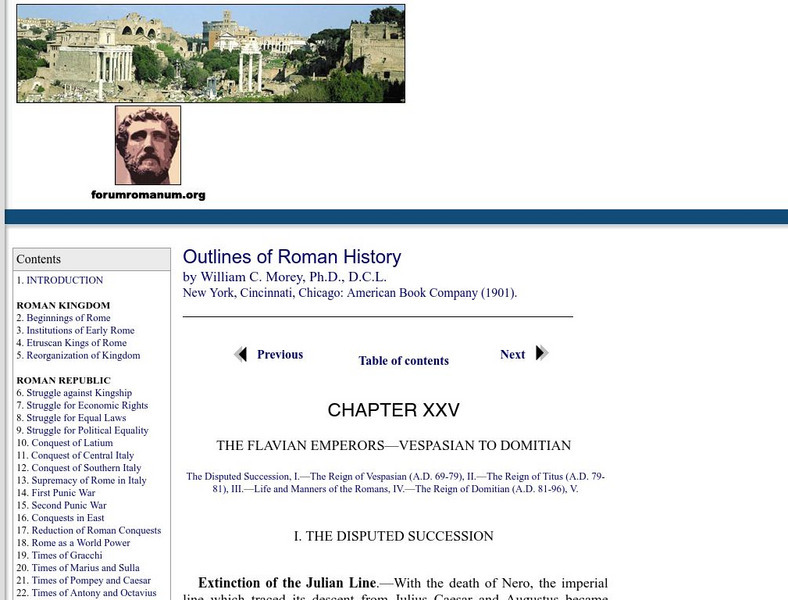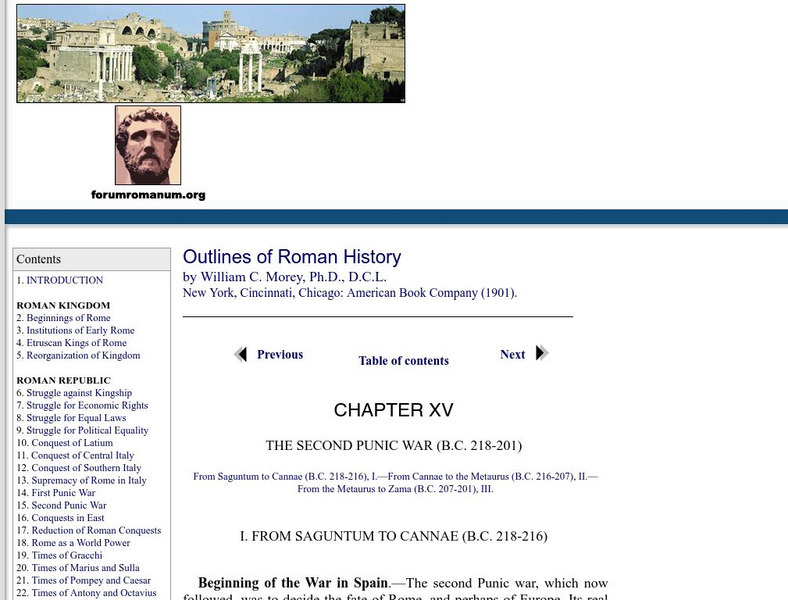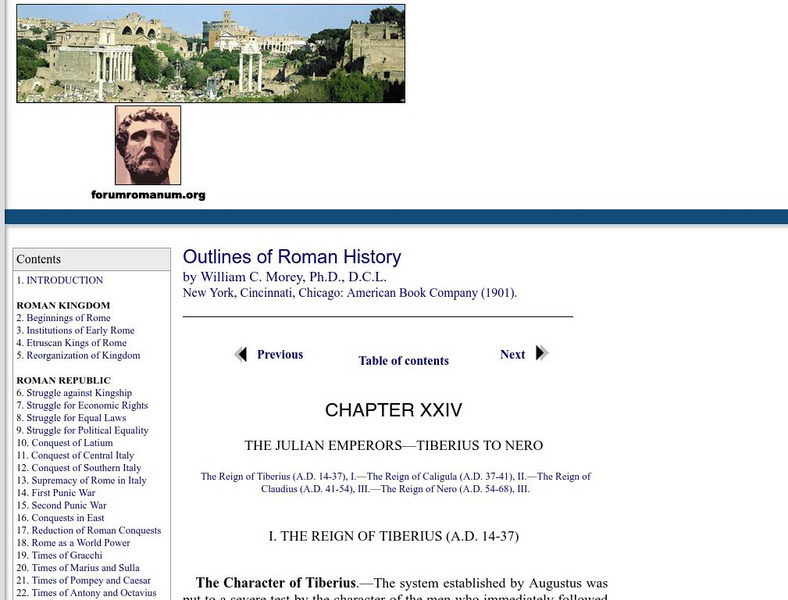Emory University
Emory University: Odyssey Online: Ancient Civilizations
Brief studies of the peoples, mythology, daily life, death and burial, writings and archaeology of civilizations in the Near East, Egypt, Greece, Rome, Africa, and the Ancient Americas.
Franco Cavazzi
Roman empire.net: The Second Triumvirate
This site from the Roman-Empire.net provides information on the Second Triumvirate (Octavian, Antony, and Lepidus) and an explanation of what happened after Caesar's death.
Forum Romanum
Outlines of Roman History: Julian Emperors: Reign of Tiberius
William Morey, in his 1901 textbook, discusses the first emperor after Augustus, Tiberius.
Forum Romanum
Outlines of Roman History: Flavian Emperors: Reign of Domitian
William Morey, in his 1901 textbook, describes the emperor Domitian, the last emperor in the Flavian dynasty.
Forum Romanum
Outlines of Roman History: Equalization of the Orders
This article shows how, through debt, agrarian, and legislative reform, the patricians and plebeians finally form a united citizenship.
Forum Romanum
Outlines of Roman History: Times of Pompey and Caesar:the Rise of Pompey
In a passage from William Morey's 1901 textbook, we learn of the military brilliance of Pompey.
Forum Romanum
Outlines of Roman History: Civil War Between Antony and Octavius
This passage in William Morey's 1901 textbook explains the hostility between Antony and Octavius and Octavius' triumph.
Forum Romanum
Outlines of Roman History: Struggle for Equal Laws
The Laws of the Twelve Tables were written down as a result of the continuing conflict between patricians and plebeians. Now laws were not secret and applied to all, regardless of class.
Forum Romanum
Outlines of Roman History: Second Secession and Its Results
Read about how the patricians finally understand the importance of the plebeians, who are then granted the right to pass laws for all and to intermarry with patricians.
Forum Romanum
Outlines of Roman History: Reforms of Tiberius and Gaius Gracchus
This chapter in William Morey's 1901 text discusses the land reforms of the Gracchi brothers. Find out how well they worked and the problems they caused.
Forum Romanum
Outlines of Roman History: The Civil War Between Marius and Sulla
In William Morey's 1901 textbook, this section considers the dispute between Marius and Sulla, resulting in a civil war.
Forum Romanum
Outlines of Roman History: Flavian Emperors: Disputed Succession
In this passage from William Morey's 1901 textbook, you read about the influence of the military in choosing four emperors in one year.
Forum Romanum
Outlines of Roman History: Flavian Emperors: Reign of Titus
William Morey offers a description of the brief reign of Titus in his textbook of 1901.
Forum Romanum
Outlines of Roman History: Second Punic War (Bc 218 201)
This chapter from William Morey's 1901 text lays out the entire course of the Second Punic War. The brilliant military strategies of Hannibal and Scipio Africanus are thoroughly explained.
Forum Romanum
Outlines of Roman History: Julian Emperors: Reign of Caligula
Read about the insanity of Caligula in William Morey's 1901 textbook.
Other
The Paintings From Boscotrecase
A art history article on a series of wall paintings belonging to the "Third Style" found in a villa near Pompeii that may have belonged to the daughter of Augustus. There are five sections, the section entitled "The Painter in Roman Art"...
Other
Mark Furnival: The Invasion of Gaul and Spain
A description of the invasion of the Gaul and Spain of the Roman Empire by the Vandals. Includes information about their eventual downfall.
Vroma Project
V Roma Project: The Circus: Roman Chariot Racing
Provides an excellent look at the chariot racing at the Circus Maximus, the history of chariot racing, and gives an example of a day at the races. this page was created by Barbara F. McManus of The College of New Rochelle.
Forum Romanum
Outlines of Roman History: The Reign of Antoninus Pius (Ad 138 161)
In this article from the 1901 textbook by William Morey, you will read about Antoninus Pius, one of the five good emperors, who was the embodiment of paternal autocracy.
Forum Romanum
Outlines of Roman History: The Reign of Marcus Aurelius (Ad 161 180)
Read this entry from William Morey's 1901 text to find out about Marcus Aurelius, one of the five good emperors, who was known as a philosopher.
Other
Musei Capitolini: Museum History
This museum is one of many under the umbrella of Rome City Council. It is also the oldest public museum in the world, having been established in 1471. Throughout the site, there is extensive information about its history and collections,...
Other
The Vatican: The Holy Father
Official site for the Vatican, the headquarters for the Roman Catholic Church. Includes information on the Vatican Library, home to thousands of historic documents, the Vatican museums, and historical and current information on the Popes...
National Gallery of Art
National Gallery of Art: Diana and Endymion
Learners will be introduced to the Greco-Roman myth of Diana and Endymion by critically analyzing a painting by Fragonard. They will then write and illustrate their own myth to describe a natural phenomenon or social custom.
That Quiz
That Quiz: Practice Test: Place Value
Test your knowledge of place value. Additional challenges include scientific notation and Roman Numerals. Seven levels of difficulty may be attempted with or without a timer.





